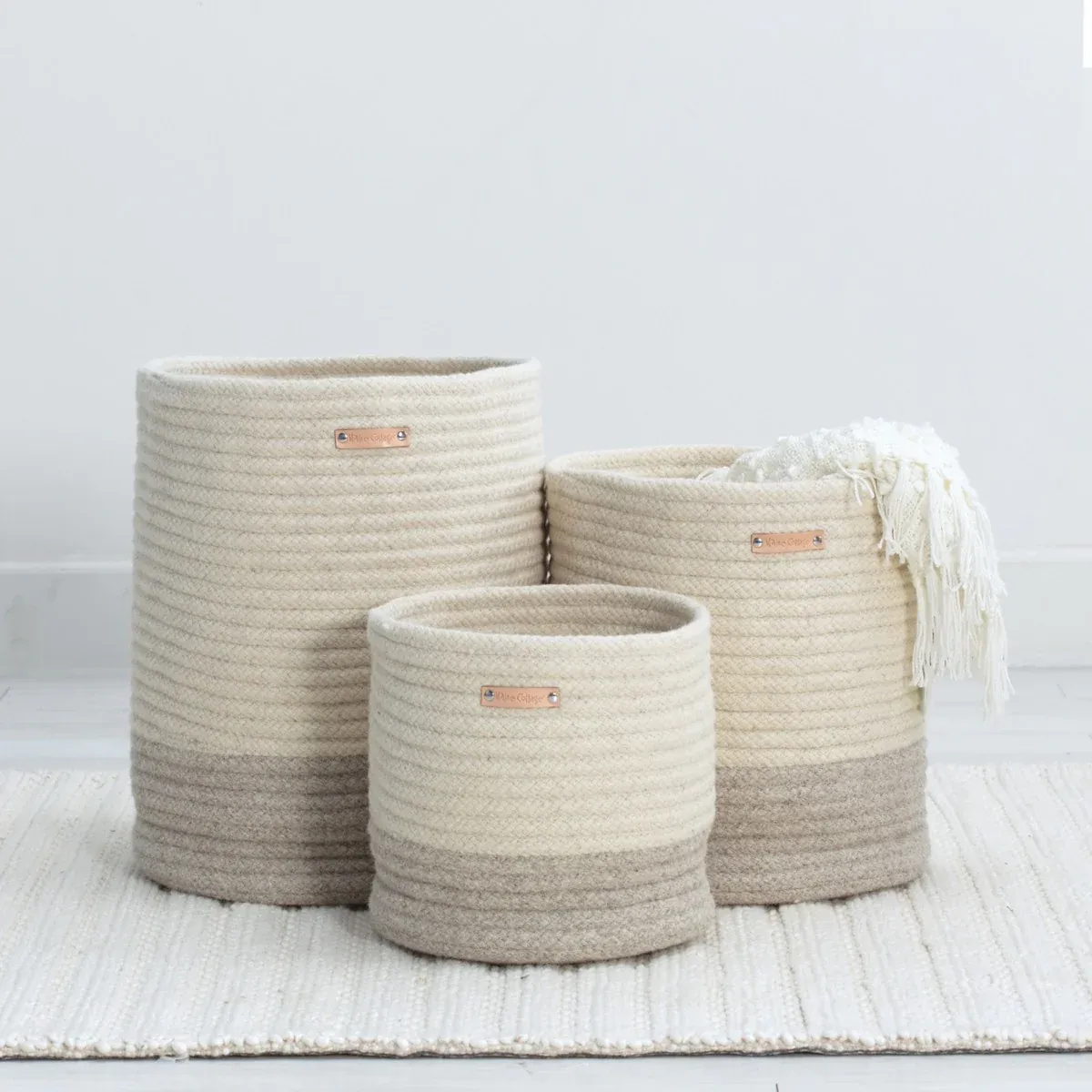The Wool Wire | October 4, 2023
Recycling is cool again, plus buried pots and wooly baskets, innovation investments, Merino 101, wool houses, and adding poof to puff.

News snippets from the wool world
My linen tops took one glance at the wool sweaters coming out of storage, had a quick tête à tête with Mother Nature, and negotiated a few more days of warm weather. The sweaters, fully aware of how long they'll be in service this winter, didn't seem to mind at all. As a reward for their patience, I've been airing them out on the porch. Everyone's happy.
This week I have loads of wooly gems for you, from big investments to buried wool, building blocks, puffy poof, baskets, and the shifting perceptions of recycled wool.
Let's go!
Everything Old is New Again
Lately I've noticed a distinct shift in how recycled wool is being marketed to consumers. What was once considered an inferior product of thrift for those who couldn't afford new wool is now gaining street cred as a valuable way to combat the grotesque waste of fast fashion.
Prato, Italy, has long been considered the capital of wool recycling. I enjoyed this article about what happens in Prato. You have to register on Bloomberg.com to read it, so I've lifted some salient quotes for you here.

The article requires that you register on Bloomberg.com
Historically, the global recycling of wool has been driven by economic opportunity and necessity, such as during disruptions in the fleece trade. Now, environmental concerns are spurring demand for recycled wool as consumers seek out clothes made primarily of reused natural fibers instead of synthetic materials, many of which can be recycled only through expensive, complex processes that involve chemicals.
But don't get too excited, because...
Wool accounts for only about 1% of global textile fiber production, so recycling discarded wool garments can’t offset the environmental impact of the global fashion industry. That sector generates an estimated 10% of the world’s carbon emissions and churns out more than 100 billion apparel items each year, or roughly 14 for every person on Earth, with tens of millions of garments tossed out every day to make way for new ones.
Even in the world of wool...
We cannot live by Merino alone, something we seem to understand in theory but not always in practice. We've talked a lot about the challenges facing the "strong wool" market, aka those somewhat coarser grades of wool grown by sheep who thrive in cool temperate climates.
I was pleased to see that WoolWorks—New Zealand's only scouring operation and the world's largest—has just announced the formation of a new division to develop new opportunities and grow the market value for wool. Innovation and research can't happen without money, and WoolWorks has the deep pockets to make progress in this arena.
“With a global move to natural and sustainable fibres through new and innovative products, models, and changes in regulations, including eco-standards, New Zealand strong wool is set to find a more meaningful place in a rapidly evolving and changing marketplace for interior textiles and emerging opportunities,” Hewett said.
Going Potty?
On a much smaller scale, two women in New Zealand have found an innovative use for wool waste in the garden—not for pellets, which we've discussed in the past, but for pots! Here's their video.
The world's first biodegradable plant pot made from 100% New Zealand wool.
Basket Case
If you'd rather not bury your wool, how about a braided wool basket instead? Here's a trio of undyed, American-made baskets from Maine Cottage.

Merino 101
Need a quick primer on the history of Merino? Much of this you may already know, but it's still a well-done summary of a lot of history.

The article also has some fabulous photos and illustrations. This may be my favorite...

There's a fungus amongus!
Looks like my dream of living in a wool house may one day become a reality. Researchers in the UK have developed a new building that uses a paste derived from the root network of the mycelium fungus in combination with a 3D-knitted wool textile framework.
"Using the knitted moulds as a flexible framework, or ‘formwork’, the scientists created mycocrete which is stronger and more versatile in terms of shape and form, allowing the scientists to grow lightweight and relatively eco-friendly construction materials."
New Zealand business is putting a crimp in things
Here's a fascinating profile of a New Zealand wool company that's doing something I didn't even know was possible. They're taking New Zealand wool and mechanically crimping it to add an average of 40 to 50% more volume, or "poof," without adding an ounce of weight to the mix.
If your goal is something to sleep, sit, or walk on, that's a big deal.
When it comes to high-quality, crimped New Zealand wool for use in sleep products, Joma Wool from John Marshall & Co. Ltd. has long been the go-to brand for mattress, pillow and topper makers worldwide, as well as furniture and home decor sources.
“It is the only crossbred wool mechanically engineered for use in the mattress/bedding industry. The bulk-to-weight ratio makes it very attractive to the end user,” says owner Peter Crone.
Will wonders never cease?
Wooly weekend ahead
And finally, for anyone lamenting that there's nothing to do this weekend, think again. If you're in Kentucky, you can check out the Kentucky Wool Festival in Falmouth, Kentucky. Or you could also head over to Montpelier Station, Virginia, for the 35th annual Fall Fiber Festival & Montpelier Sheepdog Trials.
Closer to Brooklyn, New York? You'll be just in time for the 11th annual King's County Fiber Festival. West coast? Head to Dixon, California, for Lambtown's 35th year. In Santa Fe, New Mexico, Mountain and Valley Wool Festival is celebrating its 40th year.
Or if you're here in New England, you might consider tanking up the car and making a road trip for the New Hampshire Wool Arts Tour, which is also celebrating its 40th anniversary.
And that's just this weekend alone! You'll find hundreds more wooly events, including for 2024, over at the Knitter's Review Events Calendar.
On that note, I'll end this missive and let you get back to your day. Thanks, as always, for your readership and your support.
Until next time,
Clara





